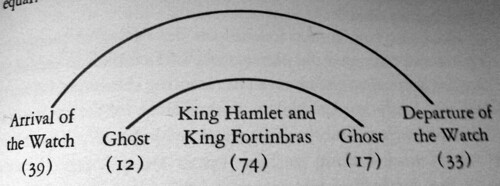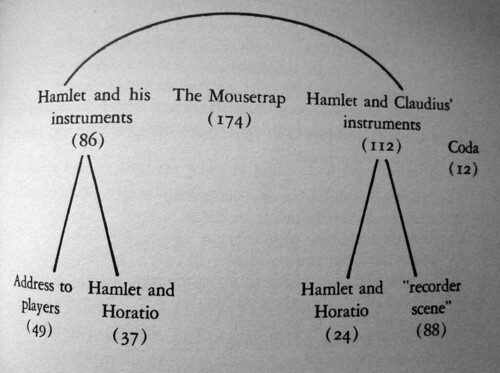Mark Rose’s slender volume, Shakespearean Design, has been on my mind recently, as I’ve been considering doing a book on ring-composition. Rose devotes a chapter to Hamlet and all but argues that it’s a ring-composition. But that–ring-composition–is not what this is about.
This is about an incidental remark in the Preface, something of an apology (p. viii):
A critic attempting to talk concretely about Shakespearean structure has two choices. He can create an artificial language of his own, which has the advantage of precision; or he can make do with whatever words seem most useful at each stage in the argument, which has the advantage of comprehensibility. In general, I have chosen the latter course.The little charts and diagrams may initially give a false impression. I included these charts only reluctantly, deciding that, inelegant as they are, they provide an economical way of making certain matters clear. The numbers, usually line totals, sprinkled throughout may also give a false impression of exactness. I indicate line totals only to give a rough idea of the general proportions of a particular scene or segment.
Here’s two of those offending diagrams, from the Hamlet chapter, pages 97 and 103 respectively; you can see the line counts in parentheses:
What’s the fuss about? And there aren’t many of them. These are simple diagrams and, yes, without them, Rose’s accounts would be more difficult to understand. Indeed, without them, a reader would be tempted to sketch their own diagrams on convenient scraps of paper.
I figure Rose’s misgivings about the numbers are about humanistic ideology, we don’t do numbers. His willies about the diagrams may be that as well, but I think there’s something more there. The diagrams themselves are problematic simply because they ARE diagrams. They intrude too deeply into the inner workings of the humanistic mind. It’s like throwing a spanner into a machine; it gums-up the works.
It’s one thing to have pictures in an illustrated edition of, say, Hamlet, pictures depicting a scene in the play. That’s fine, for it’s consistent with the narrative flow. And it’s fine to have illustrations in, say, an article about the Elizabethan theatre, where you need to depict the stage layout or the relationship between the stage and the seating. Such illustrations are consistent with the ongoing flow of thought.
Those diagrams, however regrettably necessary, are different. It’s not that they’re inconsistent with the flow of thought. They’re not. They’re essential to it. But they indicate that this kind of thinking is not quite kosher. Why not? How do these simple diagrams intrude on the humanistic mind, while more elaborate images of the type mentioned in the previous paragraph, while those images are fine?
I think it’s because the humanistic mind has somehow become fundamentally discursive–see my post, Humanistic Thought as Prose-Centric Thought. Illustrations are not problematic, because they depict whatever it is you’re thinking about. Rose’s diagrams, simple as they are, are different. Yes, they depict structure in Shakespeare’s plays, but it’s structure that is not apprehended visually. What you see on the page is one word after another, page after page. You never see scenes juxtaposed. What you see on the stage is talk after talk, action after action, but you don’t see a tableau of three or five scenes arrayed as in a multi-panel altarpiece. No, Rose’s diagrams aren’t images you think about, they’re images you are to think with, and that’s the problem. That’s what makes them intrusive.
Just why this is so, is not at all clear to me. But I’d bet it has to do with the brain. The cerebral cortex consists of some 100s of loosely distinct functional areas, each specialized for a different mental operation. I’d warrant that thinking with a diagram calls on a configuration of these functional areas that’s not normally part of the configuration used in humanistic thought. This is a matter of behavioral mode, as I’ve discussed it here and there. And that’s beyond the scope of this little note.


Hello again, BB:
ReplyDeleteThis is a top-o'-the-head, top-o'-the-mornin' fly-by response, so please forgive its brevity.
ICYMI, SK Heninger's _The Cosmographical Glass: Renaissance Diagrams of the Universe_ shows pretty conclusively how extensive the use of diagrammatic thinking was pre-1700, while Ioan Couliano's _Eros and Magic in the Renaissance_ also pretty definitively shows how the Reformation and Counter-Reformation shut down our ability to think imagistically.
https://www.amazon.com/Cosmographical-Glass-Renaissance-Diagrams-Universe/dp/0873282086
https://www.amazon.com/Magic-Renaissance-Chicago-Original-Paperback/dp/0226123162/
The two of them may be useful for any further work you do on this fascinating topic!
Thanks, Charles. Rose talks quite a bit about Renaissance visual thinking. I can believe that the Puritans shut it down. But why do humanists in the late 20th century feel that they have to toe that line?
DeleteI think it comes back in via engineering and computer science, which humanities folk may be slow to read, grasp, and grok, as they were slow to pick up on myth when it opened up again in science fiction.
DeleteMargaret Masterman's piece in Theoria to Theory would be a very early instance -- brilliant, a wide synthesis. I posted an intro here:
http://home.earthlink.net/~hipbone/IDTWeb/MMIntro.html
and an excerpt allied to my own interests here:
http://home.earthlink.net/~hipbone/IDTWeb/Master.html
One day, when I have a scanner and know how to use it, I'll post all four parts complete on the web as a public service, deus volens.
But Margaret Masterman was an exceptionally brilliant scholar. FWIW, in my senior year at Johns Hopkins I took a course in decision theory with a visiting professor in the philosophy department, R. B. Braithwaite. I didn’t know that he was also, in effect, Mr. Margaret Masterman, and it wouldn’t have meant anything to me at the time.
DeleteIn graduate school I studied with David Hays, a computational linguist. He had the highest respect for Masterman, who was a computational linguist as well. One of her students at Cambridge was a man named Martin Kay. Hays hired Kay when he was heading the machine translation program at RAND in the 1950s. Kay is now one of the grand old men of computational linguistics.
At one point Hays announced to his inner circle of students that he’d had an insight into the nature of consciousness that we wasn’t going to tell anyone, it was just too wacky. But he told Masterman; don’t know how she responded.
Hays had an off-white wool turtleneck sweater that we often wore when the weather was crisp to cold. Masterman had knitted it for him.
Here’s a post where I talk of Masterman’s work on a primitive computer program to generate crude haiku.